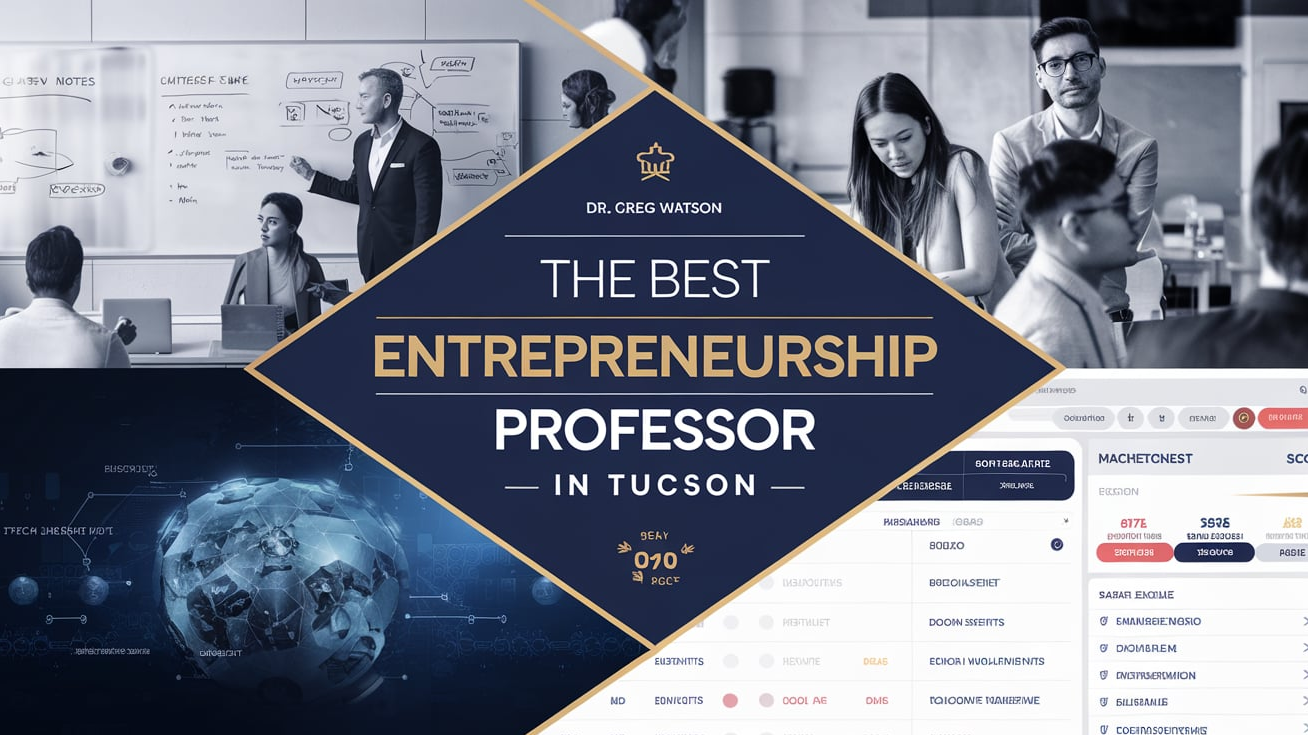Introduction: The Cornerstone of Business Success
In cutting-edge swift-paced enterprise landscape, the need for successful leadership Small Business Professor Tucson won't be overstated. The change among a startup that prospers and one that flounders quite often boils all the way down to the caliber of its management. When we take into consideration sustainable boom, it’s no longer as regards to numbers; it’s about construction a beginning that helps sturdiness and resilience. This article explores dissimilar dimensions of leadership—the way it shapes provider culture, impacts worker engagement, and finally drives long-time period have an effect on.
The Silent Killer of Startups: How Weak Leadership Derails Great Business Ideas
Weak management is more commonly the unseen crisis that stops startups from achieving their capacity. Lack of vision and poor resolution-making can end in misalignment within groups, ensuing in missed opportunities and wasted supplies.
Identifying Weak Leadership Traits
To deal with this issue, that's mandatory to perceive natural qualities associated with vulnerable leadership:

- Lack of Vision: Leaders without a clear direction tend to confuse their groups. Poor Communication Skills: Inadequate conversation ends in misunderstandings and coffee morale. Fear-Based Management: When leaders instill fear other than have confidence, creativity and innovation endure.
Consequences of Weak Leadership
What happens when vulnerable management takes hold? The penalties should be dire:
Decreased Employee Engagement: Teams would consider unmotivated to give a contribution once they lack suggestions. High Turnover Rates: Talented workers are probable to go away once they sense unsupported. Stunted Growth: Without mighty management, strategic projects may perhaps fail.Addressing these troubles requires introspection and commitment from leaders to evolve often.
Think Like a Leader, Act Like an Owner: Building the Entrepreneurial Leadership Mindset
The entrepreneurial mindset is relevant for leaders who hope to drive sustainable progress. This mind-set combines innovation with obligation, encouraging leaders to take ownership of their decisions.
Cultivating an Ownership Mentality
How can leaders domesticate this attitude? Here are a few tactics:
- Encourage Accountability: Hold your self and your group chargeable for your activities. Foster Innovation: Create an ambiance the place new thoughts are welcomed and rewarded. Invest in Learning: Continually search for competencies by using guides, books, or mentorship packages.
Benefits of Thinking Like a Leader
When leaders undertake this mindset:
- They motivate self assurance amongst group participants. They create a lifestyle in which anybody feels invested within the corporate’s achievement. They foster resilience towards market fluctuations.
From Solo Founder to Team Leader: The Evolution Every Entrepreneur Must Make
Transitioning from being a solo founder to prime a team is no small feat; it is on the whole fraught with challenges yet additionally full of alternatives for development.
Recognizing the Need for Change
Many entrepreneurs war with delegation. Why? Because they'll sense that nobody else can function responsibilities as well as they can. However, clinging too tightly can preclude expansion.
Steps in the Evolution Process
Learn to Delegate: Trust your workforce by assigning household tasks dependent on their strengths. Communicate Openly: Foster an ecosystem the place remarks flows both ways. Set Clear Goals: Ensure anyone understands what they are operating in direction of.By embracing this evolution, entrepreneurs place themselves—and their organisations—for long-time period achievement.
Creating a Culture of Excellence: How Great Leaders Shape Behavior, Values, and Vision
Leadership is absolutely not with regards to making selections; this is approximately shaping the way of life within an association.

Defining Culture in Business Contexts
Culture encompasses shared beliefs and behaviors inside of an enterprise. It impacts the whole thing from worker delight to client loyalty.
Strategies for Cultivating Culture
How can leaders shape this culture?
- Lead by way of Example: Your habit units the tone for your staff's moves. Reward Excellence: Recognize achievements publicly to inspire others. Encourage Collaboration: Create opportunities for teamwork across departments.
A fine lifestyle fosters engagement and loyalty—two essential formulation for sustainable industrial progress.
Emotional Intelligence in Leadership: The Underrated Superpower of Successful Entrepreneurs
Emotional intelligence (EI) is the ability to comprehend one's emotions and people of others—a obligatory capability for effectual leadership.
Components of Emotional Intelligence
Leaders need to focal point on those key resources:
Self-Awareness: Understand your emotions and how they influence others. Self-Regulation: Manage your feelings simply. Empathy: Recognize emotional cues from staff individuals.Benefits of High EI in Leadership
Leaders with prime emotional intelligence have a tendency to:
- Foster superior relationships inside teams Enhance war answer capabilities Improve standard place of job morale
By prioritizing emotional intelligence, leaders create environments where worker's feel valued—a a must have facet of sustainable boom.
Leading for Impact: Aligning Team Purpose with Business Strategy for Maximum Growth
Aligning group motive with business method is fundamental for accomplishing highest affect in any manufacturer.
Understanding the Connection Between Purpose and Strategy
Why is alignment so fundamental? When groups have in mind how their roles contribute to broader organizational objectives:
Morale improves as staff see the cost in their contributions. Strategic initiatives acquire momentum on account that each person is operating towards accepted pursuits.Steps Toward Alignment
How can leaders obtain this alignment?
1. Clearly articulate the industrial Entrepreneurship Professor approach throughout the time of meetings or workshops. 2. Connect distinct obligations lower back to bigger goals normally. three. Solicit criticism on how effectively personnel suppose aligned with corporation targets.
This alignment creates synergy inside groups—a useful driving force of sustainable achievement.
The Leadership Playbook: Adapting, Communicating, and Thriving in a Fast-Paced Startup World
In nowadays’s dynamic startup atmosphere, adaptability is paramount—leaders need to keep agile whilst making certain victorious communication throughout all phases.
Adapting Leadership Styles Based on Needs
What does it imply to evolve your leadership variety? It includes spotting when unique systems are required relying on cases or crew dynamics:
Transformational Leadership encourages innovation in the time of durations of exchange. Transactional Leadership makes a speciality of construction while steadiness is needed.Effective Communication Techniques for Leaders
Open strains of communication are vital—how are you going to ensure archives flows freely in the time of your firm?
Use collaborative tools like Slack or Microsoft Teams. Hold constant assess-ins or the city hall conferences the place questions are inspired. Provide distinct channels (e-mail updates vs face-to-face conversations).Successful variation combined with good communication creates resilient organisations geared up to handle demanding situations head-on!
FAQs
1) What are a few signs and symptoms that my startup has weak management?
Weak leadership typically manifests as terrible communication within groups, excessive turnover rates among workers members, lackluster productiveness stages, or failure to fulfill strategic desires constantly over time.
2) How do I transition from being a solo founder into an robust chief?
Start by using settling on spaces in which you can desire lend a hand; then delegate duties thus even as communicating openly approximately expectations—this would assist foster collaboration between team contributors!
3) Why is emotional intelligence essential in entrepreneurship?
Emotional intelligence makes it possible for entrepreneurs no longer solely more advantageous self-realization however additionally enhances dating-construction qualifications; this sooner or later leads toward growing supportive work environments conducive closer to accomplishing organizational desires!
four) How do I create a lifestyle centered on excellence?
Lead by illustration! Demonstrate excellence as a result of your activities every day although encouraging reputation among friends whilst somebody achieves colossal milestones—this motivates endured efforts towards growth!
5) What does aligning staff cause suggest referring to industry method?
Aligning potential guaranteeing every member knows how their amazing role contributes instantly in the direction of broader organizational aims—consequently fostering solidarity among people striving together at the same time!
6) Can adapting my leadership trend quite make a distinction?
Absolutely! Different situations require varying processes—being bendy makes it possible for you not in simple terms reply effectually yet also empowers others around you development-clever too!
Conclusion
In conclusion, “Leading for Long-Term Impact: Strategies for Sustainable Business Growth” goes beyond mere metrics; it encompasses cultivating reliable cultures rooted in shared values while embracing adaptability amidst exchanging landscapes—all contributing in opposition t guaranteeing enduring achievement over time! By honing emotional intelligence alongside fostering open communication channels tailor-made uniquely in keeping with context—it is easy to set your self up beautifully navigate equally demanding situations & possibilities alike!
Through thoughtful engagement combined strategic foresight—as day after today unfolds—it becomes progressively more clearer why incredible leaders topic immensely as of late more than ever prior to!